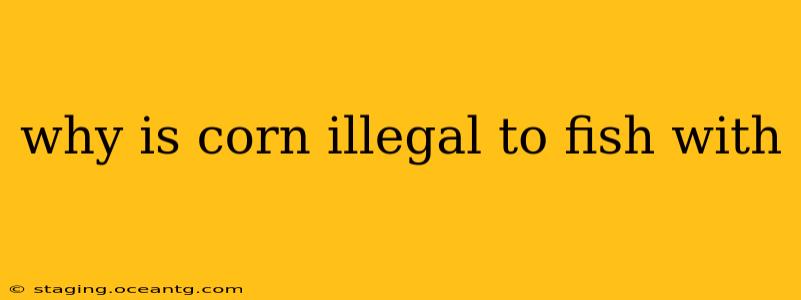Fishing regulations are often complex, and the prohibition against using corn (or certain types of corn) for fishing isn't always immediately obvious. The reasons behind such bans are multifaceted, focusing primarily on environmental protection and fair play among anglers. Let's delve into the specifics.
Why is using corn for bait sometimes illegal?
The legality of using corn as fishing bait varies significantly depending on location and specific regulations. It's not a blanket ban across all jurisdictions. However, in many areas, certain types of corn, particularly processed or chemically treated corn, are prohibited for environmental reasons.
Environmental Concerns: Pollution and Invasive Species
One of the primary concerns is the potential for water pollution. Certain types of corn, especially when used in large quantities or improperly disposed of, can contribute to excess organic matter in the water. This can lead to:
- Eutrophication: An overabundance of nutrients, resulting in algal blooms that deplete oxygen and harm aquatic life. This can severely impact fish populations and the overall health of the ecosystem.
- Habitat Degradation: Accumulated corn can smother the bottom of waterways, disrupting the natural habitat of fish and other organisms.
- Introduction of Invasive Species: Corn can sometimes inadvertently introduce or spread invasive species if it's grown using contaminated seeds or contains pest infestations.
Fairness and Conservation: Unfair Advantage
Another reason some areas restrict corn as bait is the potential for it to create an unfair advantage for some anglers. The use of large quantities of corn can overwhelm a fishing area, leading to:
- Overfishing: Attracting disproportionate numbers of fish to a single location can lead to localized overfishing and depletion of the fish population in that area.
- Disturbing other Anglers: Corn, particularly when thrown out en masse, can attract excessive numbers of fish, which might then interfere with other anglers using different methods. This would not be considered fair angling practices.
What types of corn are typically restricted?
It's often not the corn itself, but its processing or treatment that raises concern. For example:
- Sweetened Corn: The added sugar in sweetened corn can contribute further to water pollution and encourage harmful algal blooms.
- Chemically Treated Corn: Corn treated with pesticides or herbicides can introduce harmful chemicals into the waterway, endangering aquatic life and potentially contaminating the fish themselves.
- Large Quantities: Even if the corn is naturally grown and untreated, using it in excessive quantities can still contribute to negative environmental impacts.
What are the alternatives to corn for fishing?
There are plenty of environmentally friendly and effective bait options available, including:
- Natural Baits: Worms, insects, minnows, and other natural baits are typically preferred and pose less risk to the environment.
- Artificial Lures: A vast range of artificial lures mimic natural prey and avoid the risks associated with corn and other organic baits.
Is there any legal way to use corn for fishing?
The use of corn for fishing often depends on regional regulations. In some areas, smaller amounts of naturally grown, untreated corn might be permitted, but it's always crucial to check the specific rules and regulations applicable to the location where you intend to fish. Always consult the relevant fisheries authority's guidelines before using any type of bait.
Where can I find the specific regulations for my area?
Contact your local Department of Natural Resources or Fisheries and Wildlife agency for detailed regulations and restrictions for your specific fishing location. Their websites usually contain up-to-date information, including a list of permitted and prohibited baits. Failing to comply with these regulations can result in fines and other penalties.
By understanding the environmental and ethical concerns, anglers can make informed decisions about their bait choices and contribute to the sustainable management of fish populations and aquatic ecosystems.
